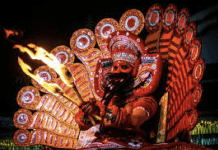
Guru Purnima (also known as Poornima) is a revered religious festival celebrated by Hindus, Jains, and Buddhists in India, Nepal, and Bhutan. It holds great significance as a day to pay respect to spiritual teachers and leaders, and is also recognized as Vyasa Purnima or Asadha Purnima. The festival takes place on the full moon day (Purnima) in the month of Ashadha, which typically falls in June or July according to the Hindu calendar.
Understanding the Guru: Dispeller of Darkness and Ignorance
The term “guru” originates from the Sanskrit words “gu” meaning “darkness” or “ignorance,” and “ru” meaning “dispeller.” Hence, a guru is regarded as the one who dispels darkness and ignorance, guiding individuals towards enlightenment and knowledge.
Significance and Observances of Guru Purnima in Hinduism
The celebration of Guru Purnima is characterized by various spiritual activities, including the ritualistic event of Guru puja, dedicated to honoring the guru or teacher, embodying the revered guru-shishya (teacher-student) tradition. Gurus hold immense importance in the lives of many, and on this day, disciples offer puja and show deep respect towards their chosen spiritual guides. Moreover, this festival holds great importance within the realm of academia and scholarly pursuits in India. Indian academics express gratitude towards their teachers, while also commemorating past teachers and scholars who have made significant contributions.
Lord Shiva: The Adi Guru
Within the yogic tradition, Guru Purnima holds a special association with Lord Shiva, who is recognized as the first guru or “Adi Guru.” It is believed that Lord Shiva initiated the transmission of Yoga to the Saptarishis (the seven sages). According to ancient accounts, Lord Shiva appeared in the upper regions of the Himalayas several millennia ago, captivating a large gathering with his extraordinary presence. Although he showed no signs of life in his incarnation, tears of ecstasy flowed from his eyes intermittently, signifying a profound spiritual awakening.
Vyasa Purnima
In Hindu mythology, Guru Purnima serves as a celebration of the birth of the sage Ved Vyasa, also known as Vyasa (birth name Krishna Dvaipayana). Vyasa holds authorship of the Mahabharata, a revered epic, and is credited with compiling the Vedas. His notable accomplishment includes dividing the Vedas into four parts: Rigveda, Samaveda, Yajurveda, and Atharvaveda. Seeking the blessings of Ved Vyasa is considered auspicious on Guru Purnima, as he is venerated as the “Maha Guru” or the great teacher. His blessings are believed to dispel the darkness of ignorance, illuminating the path of knowledge.
Guru Purnima in Buddhism: Commemorating the First Sermon
For Buddhists, Guru Purnima holds significant importance as it marks the day when Gautam Buddha delivered his first sermon to his initial five disciples in Sarnath. Known as the Dharmacakrapravartana Sūtra, this sermon led to the enlightenment of those disciples, establishing the mendicant Sangha. Gautam Buddha then spent his first rainy season at the Mulagandhakuti in Sarnath.
Buddhists celebrate this festival in honor of the Buddha, who imparted his teachings on this auspicious day. Observances include practicing uposatha, which involves adhering to eight precepts. Vipassana meditators engage in meditation under the guidance of their teachers. Additionally, Guru Purnima also marks the beginning of the rainy season vassa, which spans three lunar months from July to October. During this period, Buddhist monks remain in one place, typically in their temples, engaging in intensive meditation and spiritual practices. Laypeople often use this time to rejuvenate their spiritual training and embrace more ascetic practices, such as abstaining from meat, alcohol, or smoking.
Guru Purnima in Jainism: Honoring Mahavira and the Path to Enlightenment
In Jainism, Guru Purnima holds special significance as the day when Mahavira, the twenty-fourth “tirthankara” or spiritual teacher, accepted Indrabhuti Gautam as his first disciple. Tirthankaras are revered figures who have transcended the cycle of life and death, attaining “kaivalya” or liberation from worldly illusions.
After attaining “kaivalya,” Mahavira became the Guru, or “Treenok Guha,” to Indrabhuti Gautam, also known as Gautam Swami. Guru Purnima, therefore, is often referred to as “Guha Purnima” among Jains, who celebrate it in reverence to their “Treenok Guha” or Mahavira.
Guru Purnima is a festival that unifies Hindus, Buddhists, and Jains in their collective reverence for spiritual teachers and leaders. It serves as a day to express gratitude, seek blessings, and commemorate the profound wisdom and guidance imparted by these revered figures.



























































